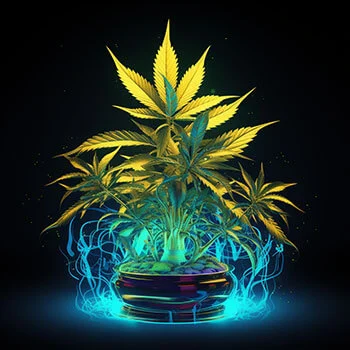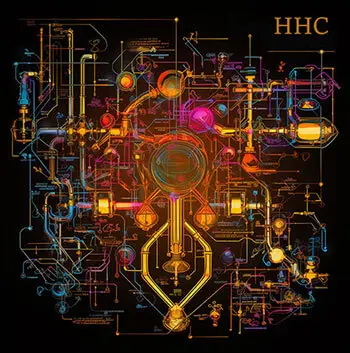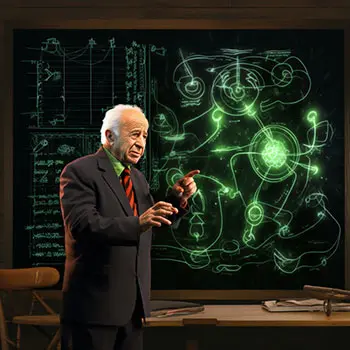Cannabis, THC and CBD: An in-depth look at their influence on sleep and circadian cycles
| INDEX | |
|---|---|
| Índice Artículo "Cannabis, THC y CBD: Un vistazo profundo a su influencia en el sueño y los ciclos circadianos" | |
We find ourselves facing a world in which we constantly live with stress and anxiety, causing a decrease in the quality of sleep.
There are many questions that have arisen in recent years for researchers regarding this topic, the most notable being the following:
How do different cannabinoids influence a person's sleep cycles?
What is the impact of cannabis on long-term sleep?
Is there an optimal dose to improve sleep?
What is the role of endocannabinoids in sleep regulation?
What is the impact of different ratios of THC and CBD?
Stay with us on this journey towards understanding the mechanisms behind a good night's sleep!
Cannabinoid Paradigm for Sleep
In the constant search for solutions to improve the quality of sleep, more and more studies are being carried out to be able to discover in depth all those topics on which it influences.
Emphasis has been placed on its possible therapeutic use in the treatment of some common sleep disorders such as insomnia, breathing disorders during sleep, restless legs and some less common disorders such as narcolepsy and parasomnias.
Regarding cannabinoids, in an introductory way, mention that, as we already said in the Article of "Cannabis and CBD: origin, varieties and main cannabinoids", are found in the cannabis plant. In it, we can find more than 500 organic elements, of which, currently, 113 are considered cannabinoids.
De todos los cannabinoides conocidos, hoy en día, el más estudiado ha sido el THC (tetra-hidrocannabinol) seguido del CBD (cannabidiol). Esto se debe a que, ya desde antaño, era conocido por su uso terapéutico. Destaca por su empleo como psicotrópico, para inducir el sueño y en afecciones como las pesadillas relacionadas con el trastorno de estrés postraumático (TEPT).
Sleep Physiology
La fisiología del sueño es como un concierto bien coordinado en tu cerebro y cuerpo. Es como si el cerebro fuera la orquesta y las diferentes partes del cuerpo fueran los músicos.
Sleep is divided into 2 parts: REM and NREM.
REM: Rapid Eye Movement
In this phase you dream and your brain is active.
NREM: Non-Rapid Eye Movement
In this phase your body is relaxed and repairs itself.
Regulation of the sleep-wake cycle is a complex interaction between several neuroanatomical and neurochemical systems.
On the one hand, REM sleep is regulated by neurons present in the pons and hypothalamus. These areas are responsible for sending signals that activate REM sleep. It is during this phase when brain activity is similar to when we are awake, however, the main muscles are paralyzed.
On the other hand, NREM sleep is regulated by neurons in preoptic areas of the brain, for example, the ventrolateral preoptic nucleus. These neurons play a very important role in the inhibition of ascending excitatory systems. It is during this phase when the body experiences several stages, from lighter sleep to deeper sleep, where brain activity gradually decreases.
In addition, it should be mentioned that respiratory patterns also vary during sleep. In this way, during the REM phase, the pattern is more irregular, and, in the NREM phase, the pattern is more regular.
In summary, when you fall asleep, your brain and body go into action, repairing you and consolidating your memories. This is how it ensures that you wake up fresh and energized the next day. It helps you maintain your physical and mental health.
Sleep Cycles
So that you can understand the influence of cannabis on sleep cycles, we are going to first explain all the phases that a person goes through when they go to sleep.
We already mentioned the NREM and REM phase in a previous section, but there is still more. Let's get to it!
-
- Phase 1: It is the transition between wakefulness and sleep. This is a light phase and muscle activity is reduced. During this stage, alpha waves predominate, which are waves of low amplitude and frequency. It usually lasts an average of between 5 and 10 minutes. (This phase is where it usually happens that we think we are falling out of bed. Don't worry!)
- Phase 2: It is characterized by a further decrease in muscle activity and the onset of specific brain wave activity. In phase 2, K complexes and sleep spindles, waves higher frequency rapids. Its approximate duration is between 10 and 25 minutes. (In this phase we consolidate the information and improve performance in the acquired motor skills)
-
- Phase 3: This is the deep sleep phase, where slow or high-amplitude brain waves (delta waves) are prominent . This is a decisive phase for physical recovery. Delta waves predominate, which are low-frequency, high-amplitude brain waves. (This phase is where nightmares usually occur)
- Phase 4: It is the phase where brain activity is similar to wakefulness and the eyes make rapid eye movements in different directions. It's where vivid dreams happen. beta waves prevail, very similar to waking waves, with rapid and desynchronized brain activity. (If we are awakened during this phase it is very possible that we will remember what we were dreaming about)

Influence of Cannabis on Sleep
Once we know a person's Sleep Phases, we are going to see how cannabis influences each one.
It must be taken into account that this type of study is currently being developed, so it is very likely that little by little we will learn more about its effects on sleep.
Various studies carried out conclude that the effect of THC is different from that of CBD, and, in itself, from the combination of both. It must also be emphasized that studies with CBD are still very recent. However, THC studies have been going on for many more years and therefore, there is more information about it.
Historically, cannabis has been documented to promote sleep indicating beneficial effects in reducing sleep onset latency and increasing total sleep time, decreasing REM sleep, and achieving slow wave sleep. There are surveys that suggest that medicinal cannabis reduces the use of sleep medications in 2/3 of patients.
Other studies on THC and sleep mention that this cannabinoid, when signs of tolerance and withdrawal are observed, tends to reduce the time we spend in phases 1 and 2, which can cause a decrease in sleep quality. Furthermore, during phase 3 it could reduce delta waves, affecting proper physical recovery.
On the other hand, the study mentions that it can reduce the time needed to go from wakefulness to phase 1, helping us combat different sleep disorders.
The debate regarding THC and sleep is very varied since there are not enough studies and, in addition, the effect of tolerance and its effect on abstinence when prolonged consumption has occurred is being assessed. Therefore, we have no choice but to wait a little longer to learn about this great topic.
Studies conducted on the use of CBD have shown mixed results. An improvement in sleep quality has been reported with moderate-high doses and anxiolytic properties.
During Phase 1, it could help us relax and fall asleep. In the rest of the phases there are no significant impacts. However, it must be emphasized that it is a very recent topic and is being studied today.
Additionally, formulations that combine CBD and THC, such as Sativex extract, have shown improvements without evidence of significant tolerance.
Endocannabinoids and Circadian Rhythm
The endocannabinoid system (ECS) plays a crucial role in the regulation of the circadian rhythm, influencing the suprachiasmatic nuclei through the GABAergic effect of the CB1 receptor.
Studies in rodents suggest that endocannabinoids have fluctuating levels during the sleep-wake cycle, affecting sleep quality, especially during the dark phase. Administration of certain compounds, such as 2-AG, can modulate sleep stages in rodents.
In humans, THC administration appears to influence the pronunciation of circadian rhythms by influencing the synchronization of the internal biological clock that controls sleep and wake cycles.
The relationship between the endocannabinoid system and circadian rhythms may have significant implications for the regulation of sleep at different times of the day, which could be relevant for those experiencing sleep disorders related to disruption of circadian patterns. For this reason, various therapeutic applications are being explored for these compounds in circadian rhythm disorders.
Human Studies
Research in humans supports the findings in animal models.
Inhalation of CBD-dominant cannabis has been observed to increase subjective sleepiness, while CBD only appears to have a limited impact on sleepiness.
Larger-scale controlled clinical studies are ongoing to evaluate the effects of THC and CBD in patients with diagnosed insomnia.
Comparison THC vs CBD in Sleep

En conclusión, la relación entre el cannabis, el THC y el CBD con el sueño es compleja y multifacética. Mientras que el THC puede inicialmente mejorar el sueño, pero con riesgo de tolerancia, el CBD muestra resultados más variados, dependiendo de la dosis y las combinaciones con otros cannabinoides. La investigación actual destaca la necesidad de estudios adicionales para comprender completamente cómo estos compuestos afectan nuestros ciclos de sueño y cómo se pueden utilizar terapéuticamente.
Conclusion
Emphasize that, in terms of doses and combinations of cannabinoids, research is focused on understanding how specific proportions of THC and CBD, as well as other phytocannabinoids present in different strains of cannabis, can uniquely affect sleep quality.
Various studies have shown that CBD, unlike THC, may have properties that improve wakefulness, and the combination of both in certain proportions could have synergistic or counteracting effects in promoting sleep.
In summary, the impact of cannabis on sleep is a fascinating and complex area of research. Although significant progress has been made in understanding how cannabinoids can affect sleep patterns, much remains to be discovered.
La variabilidad individual, la dosis, la cepa y otros factores complican el panorama. Se necesitan más estudios para establecer pautas claras sobre el uso terapéutico del cannabis en relación con el sueño.
You can download the article at the following link:






